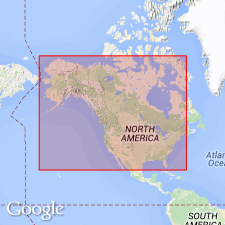
- Usage in publication:
-
- Coos conglomerate
- Modifications:
-
- Named
- Dominant lithology:
-
- Conglomerate
- AAPG geologic province:
-
- Western Columbia basin
Summary:
Pg. 336-343. Coos conglomerate. A singular formation at Fossil Point, Coos Bay, Oregon. Consists of Miocene fossils, small waterworn chert pebbles, sand, and a few fossil forms still living in vicinity, cemented into hard conglomerate. Rests on eroded surface of Empire formation. Only fragments of original deposit remain, the rest having been eroded, though originally some 10 feet thick. The Miocene fossils are from Empire beds; source of chert unknown. The only part of the conglomerate that may be regarded as strictly contemporaneous with its deposition comprises the rather small proportion of Pleistocene fossils and sand which is intermixed with the rehandled older material.
[Misprint: on p. 515 (US geologic names lexicon, USGS Bull. 896) Dall, 1897 (USGS 18th Ann. Rept.) should be 1898.]
Source: US geologic names lexicon (USGS Bull. 896, p. 515).
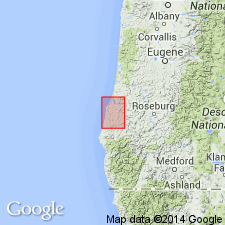
- Usage in publication:
-
- Coos conglomerate
- Modifications:
-
- Overview
- AAPG geologic province:
-
- Western Columbia basin
Summary:
Coos conglomerate, named by Dr. Dall, consists of 30 feet of consolidated conglomerate, cross-bedded, generally known as "Fossil Rock," on account of large number of conspicuous fossil shells it contains, some of which represent living species, but larger part were derived by erosion directly from underlying fossiliferous Empire beds. Dall says probably Pleistocene. Exposed extent covers about 1 acre.
Source: US geologic names lexicon (USGS Bull. 896, p. 515).
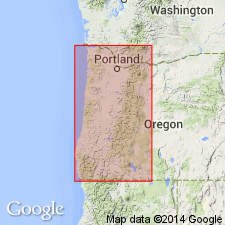
- Usage in publication:
-
- Coos conglomerate
- Modifications:
-
- Age modified
- AAPG geologic province:
-
- Western Columbia basin
Summary:
Pg. 6-7. Assigned Coos conglomerate to upper Pliocene, and stated that it contains a mixed fauna of living, Pliocene, and Miocene fossils. H.V. Howe, 1921 (GSA Bull., v. 32, p. 147), also assigned the conglomerate to Pliocene.
Source: US geologic names lexicon (USGS Bull. 896, p. 515).
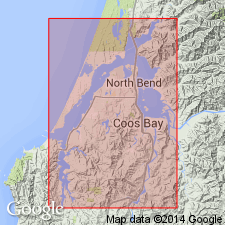
- Usage in publication:
-
- Coos conglomerate
- Modifications:
-
- Age modified
- AAPG geologic province:
-
- Western Columbia basin
Summary:
Pg. 86-91. Coos conglomerate is an integral part of Pliocene series of South Slough syncline. That it represents a time break is evident from its composition, but that this break is not great enough to bridge remainder of Pliocene is seen both by its fauna and stratigraphic position. The fauna listed by Dall contains only 3 species not contained in beds below. To Merriam and Lawson should go credit of first correctly determining Pliocene age of Coos conglomerate. It is not Pleistocene, as assigned by Dall. Unconformably overlies Empire formation and unconformably underlies massive unfossiliferous sandstones of Pleistocene age.
Source: US geologic names lexicon (USGS Bull. 896, p. 515).
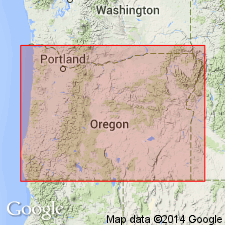
- Usage in publication:
-
- Coos conglomerate
- Modifications:
-
- Overview
- AAPG geologic province:
-
- Western Columbia basin
Summary:
Pg. 73. Assigned Coos conglomerate to Pliocene, as did L.G. Hertlein and C.H. Crickmay, 1924 (Amer. Phil. Soc. Proc., v. 63, no. 2).
Source: US geologic names lexicon (USGS Bull. 896, p. 515).
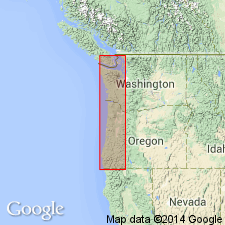
- Usage in publication:
-
- Coos conglomerate
- Modifications:
-
- Overview
- AAPG geologic province:
-
- Western Columbia basin
Summary:
Pg. 264-270. Coos conglomerate appears to be without doubt Pliocene. [Gives resume of literature.]
Source: US geologic names lexicon (USGS Bull. 896, p. 515).
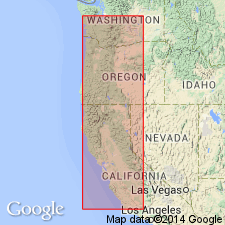
- Usage in publication:
-
- Coos conglomerate lentil
- Modifications:
-
- Revised
- AAPG geologic province:
-
- Western Columbia basin
Summary:
Coos conglomerate lentil in Empire formation. Coos conglomerate considered a lens in Empire formation.
Source: US geologic names lexicon (USGS Bull. 1200, p. 930).
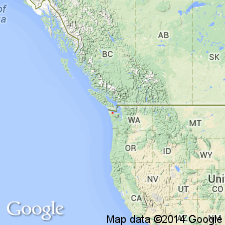
- Usage in publication:
-
- Coos Conglomerate Member
- Modifications:
-
- Revised
- Age modified
- AAPG geologic province:
-
- Western Columbia basin
Summary:
Coos Conglomerate reduced in rank to Coos Conglomerate Member and assigned to Empire Formation and its Wishkahan Stage (new name) in southwestern Oregon. Age changed from early Pliocene --to-- early late Miocene.
Source: Changes in stratigraphic nomenclature, 1977 (USGS Bull. 1457-A, p. A21).
For more information, please contact Nancy Stamm, Geologic Names Committee Secretary.
Asterisk (*) indicates published by U.S. Geological Survey authors.
"No current usage" (†) implies that a name has been abandoned or has fallen into disuse. Former usage and, if known, replacement name given in parentheses ( ).
Slash (/) indicates name conflicts with nomenclatural guidelines (CSN, 1933; ACSN, 1961, 1970; NACSN, 1983, 2005, 2021). May be explained within brackets ([ ]).

